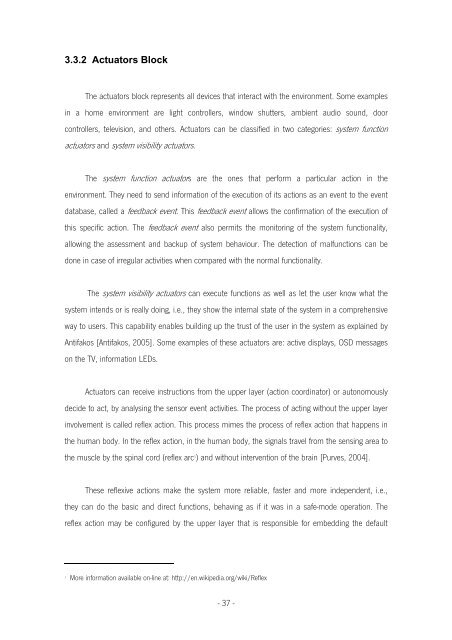Carlos Manuel Rodrigues Machado Autonomic Ubiquitous Computing
Carlos Manuel Rodrigues Machado Autonomic Ubiquitous Computing
Carlos Manuel Rodrigues Machado Autonomic Ubiquitous Computing
Erfolgreiche ePaper selbst erstellen
Machen Sie aus Ihren PDF Publikationen ein blätterbares Flipbook mit unserer einzigartigen Google optimierten e-Paper Software.
3.3.2 Actuators Block<br />
The actuators block represents all devices that interact with the environment. Some examples<br />
in a home environment are light controllers, window shutters, ambient audio sound, door<br />
controllers, television, and others. Actuators can be classified in two categories: system function<br />
actuators and system visibility actuators.<br />
The system function actuators are the ones that perform a particular action in the<br />
environment. They need to send information of the execution of its actions as an event to the event<br />
database, called a feedback event. This feedback event allows the confirmation of the execution of<br />
this specific action. The feedback event also permits the monitoring of the system functionality,<br />
allowing the assessment and backup of system behaviour. The detection of malfunctions can be<br />
done in case of irregular activities when compared with the normal functionality.<br />
The system visibility actuators can execute functions as well as let the user know what the<br />
system intends or is really doing, i.e., they show the internal state of the system in a comprehensive<br />
way to users. This capability enables building up the trust of the user in the system as explained by<br />
Antifakos [Antifakos, 2005]. Some examples of these actuators are: active displays, OSD messages<br />
on the TV, information LEDs.<br />
Actuators can receive instructions from the upper layer (action coordinator) or autonomously<br />
decide to act, by analysing the sensor event activities. The process of acting without the upper layer<br />
involvement is called reflex action. This process mimes the process of reflex action that happens in<br />
the human body. In the reflex action, in the human body, the signals travel from the sensing area to<br />
the muscle by the spinal cord (reflex arc 1 ) and without intervention of the brain [Purves, 2004].<br />
These reflexive actions make the system more reliable, faster and more independent, i.e.,<br />
they can do the basic and direct functions, behaving as if it was in a safe-mode operation. The<br />
reflex action may be configured by the upper layer that is responsible for embedding the default<br />
1 More information available on-line at: http://en.wikipedia.org/wiki/Reflex<br />
- 37 -

















